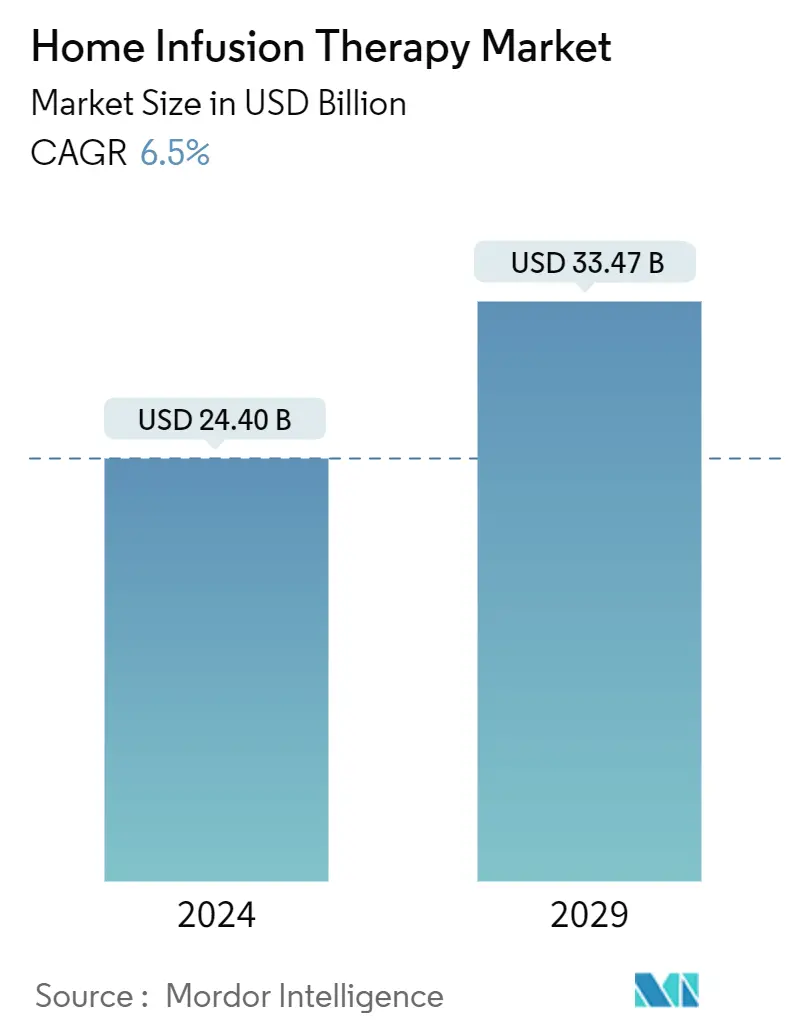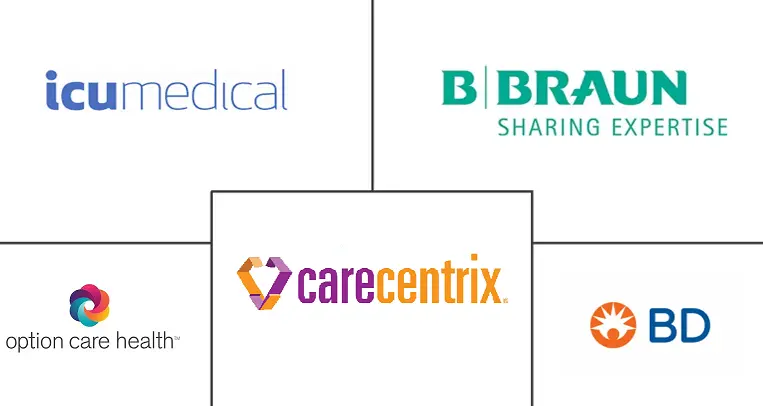Market Size of Home Infusion Therapy Industry

| Study Period | 2019 - 2029 |
| Market Size (2024) | USD 24.40 Billion |
| Market Size (2029) | USD 33.47 Billion |
| CAGR (2024 - 2029) | 6.50 % |
| Fastest Growing Market | Asia Pacific |
| Largest Market | North America |
Major Players
*Disclaimer: Major Players sorted in no particular order |
Home Infusion Therapy Market Analysis
The Home Infusion Therapy Market size is estimated at USD 24.40 billion in 2024, and is expected to reach USD 33.47 billion by 2029, growing at a CAGR of 6.5% during the forecast period (2024-2029).
- As cases of COVID-19 increased in 2020, the use of alternate site solutions rose in high demand, and home and specialty infusion providers played a critical role in supporting patients. However, initiatives by key market players were expected to increase market growth. For instance, in July 2021, Eitan Medical opened a new office for the DACH region located in Germany to expand its customer base. Its Sapphire infusion system was EU MDR certified and served clinicians in hospitals and home care environments across Europe. The pump was designed to deliver a wide range of therapies for varied clinical use cases. Similarly, in January 2021, Amedisys collaborated with Option Care Health to deliver COVID-19 infusion therapy to the vulnerable population. Thus, such initiatives were expected to increase market growth.
- The growth of the market is attributed to improved patient outcomes, cost-efficiency, and patient convenience provided by home infusion therapy. The growing number of baby boomers suffering from decreased mobility profiles such as osteoarthritis, paralysis, and diabetes will boost the demand for home infusion therapy. The rising need to reduce the duration of inpatient stays is anticipated to fuel the market development. Continuous subcutaneous (SC) apomorphine infusion is an effective therapy for Parkinson's disease (PD), and various drug formulations are available for treating PD using the subcutaneous mode of delivery. Thus, with the increasing burden of PD, the demand for subcutaneous infusion therapy is rising.
- For instance, as per the 2022 data update by the Parkinson's Foundation, approximately 90,000 people are diagnosed with PD annually in the United States, and nearly 1.2 million people in the country are estimated to be living with PD by the year 2030. In addition, as per the source above, the incidence of PD has increased in North America in the past decade, and it is estimated that men are associated with a higher incidence of PD than women.
- As a result, techniques for administering infusion therapy at home or in other healthcare settings have been developed, which is also anticipated to support market expansion. The majority of home infusion providers still use conventional infusion pumps despite hospitals quickly adopting smart infusion pumps with fascinating features like EHR connectivity, drug libraries, and medication safety software. However, there has been a growing trend for the up-gradation of equipment owing to its increasing demand, especially in developed countries.
- Furthermore, in December 2021, Baxter International completed the acquisition of Hillrom. This acquisition will help the company broaden its geographic footprint and integrate medical device technology that will enhance patient care, lower costs, and increase workflow efficiency. Moreover, in March 2021, Terumo and Glooko, a remote patient monitoring software and mobile apps company, announced technological integration to deliver new diabetes data solutions together globally. The partnership will allow the integration of data from Terumo's diabetes care devices into Glooko'sdiasend diabetes data management platform. Similarly, in June 2021, Aducanumab (Aduhelm) received accelerated approval as a treatment for Alzheimer's disease from the United States Food and Drug Administration (FDA). This is the first FDA-approved infusion therapy to address the underlying biology of Alzheimer's disease. Thus, such acquisitions and product launches are expected to boost the growth of the market over the forecast period. However, the high cost associated with the infusion pumps may hamper business growth during the forecast period.
Home Infusion Therapy Industry Segmentation
Home infusion therapy involves the intravenous or subcutaneous administration of drugs or biologicals to an individual at home. The components needed to perform home infusion include the drug, equipment, and supplies.
The home infusion therapy market is segmented by products, applications, and geography. By product, the market is segmented as infusion pump sets and accessories and consumables. By applications the market is segmented as total parenteral nutrition, anti-infective therapy, enteral nutrition, hydration therapy, chemotherapy, IVIG/specialty pharmaceuticals, and other applications). By geography, the market is segmented as North America, Europe, Asia-Pacific, Middle-East and Africa, and South America. The market report also covers the estimated market sizes and trends for 17 different countries across major regions globally.
The report offers the value (in USD) for the above segments.
| By Product | |
| Infusion Pump Sets | |
| Accessories and Consumables |
| By Applications | |
| Total Parenteral Nutrition | |
| Anti-infective Therapy | |
| Enteral Nutrition | |
| Hydration Therapy | |
| Chemotherapy | |
| IVIg/Specialty Pharmaceuticals | |
| Other Applications |
| Geography | ||||||||
| ||||||||
| ||||||||
| ||||||||
| ||||||||
|
Home Infusion Therapy Market Size Summary
The home infusion therapy market is poised for significant growth, driven by the increasing demand for patient-centric care solutions that offer improved outcomes, cost efficiency, and convenience. The market's expansion is supported by the rising prevalence of chronic conditions among the aging population, such as osteoarthritis, paralysis, and diabetes, which necessitate home-based therapies. The shift towards reducing inpatient stays further fuels this growth, as does the rising burden of Parkinson's disease, which has led to increased demand for subcutaneous infusion therapies. Technological advancements and strategic initiatives by key players, such as the expansion of Eitan Medical in Europe and collaborations like that of Amedisys and Option Care Health, have also played a crucial role in enhancing market dynamics. Despite the high costs associated with infusion pumps, the market continues to evolve with innovations and partnerships aimed at improving patient care and operational efficiency.
Regionally, North America stands out as a major contributor to the home infusion therapy market, driven by the high prevalence of chronic diseases, technological advancements, and favorable insurance coverage for home healthcare services. The migration from acute to home care settings, due to cost-effectiveness and improved patient mobility, further propels market growth in this region. The market is characterized by moderate competition, with both global and regional players like B. Braun Melsungen AG, ICU Medical, and Option Care Health Inc. actively participating. Recent developments, such as Baxter International's FDA clearance for new infusion pumps and KORU Medical Systems' collaboration for subcutaneous immunoglobulin therapy, highlight the ongoing innovation and strategic partnerships shaping the market landscape. The anti-infective therapy segment is expected to dominate, driven by the increasing prevalence of infectious diseases and heightened awareness activities.
Home Infusion Therapy Market Size - Table of Contents
-
1. MARKET DYNAMICS
-
1.1 Market Overview
-
1.2 Market Drivers
-
1.2.1 Growing Number of Baby Boomers Suffering From Decreased Mobility
-
1.2.2 Growing Incidence of Hospital-acquired Infections
-
1.2.3 Increasing Adoption of Home Healthcare Coupled with Technological Advancements
-
-
1.3 Market Restraints
-
1.3.1 High Cost of Infusion Pumps
-
1.3.2 Safety Issues Associated with Infusion Pumps
-
-
1.4 Porter's Five Forces Analysis
-
1.4.1 Threat of New Entrants
-
1.4.2 Bargaining Power of Buyers/Consumers
-
1.4.3 Bargaining Power of Suppliers
-
1.4.4 Threat of Substitute Products
-
1.4.5 Intensity of Competitive Rivalry
-
-
-
2. MARKET SEGMENTATION (Market Size By Value- USD)
-
2.1 By Product
-
2.1.1 Infusion Pump Sets
-
2.1.2 Accessories and Consumables
-
-
2.2 By Applications
-
2.2.1 Total Parenteral Nutrition
-
2.2.2 Anti-infective Therapy
-
2.2.3 Enteral Nutrition
-
2.2.4 Hydration Therapy
-
2.2.5 Chemotherapy
-
2.2.6 IVIg/Specialty Pharmaceuticals
-
2.2.7 Other Applications
-
-
2.3 Geography
-
2.3.1 North America
-
2.3.1.1 United States
-
2.3.1.2 Canada
-
2.3.1.3 Mexico
-
-
2.3.2 Europe
-
2.3.2.1 Germany
-
2.3.2.2 United Kingdom
-
2.3.2.3 France
-
2.3.2.4 Italy
-
2.3.2.5 Spain
-
2.3.2.6 Rest of Europe
-
-
2.3.3 Asia-Pacific
-
2.3.3.1 China
-
2.3.3.2 Japan
-
2.3.3.3 India
-
2.3.3.4 Australia
-
2.3.3.5 South Korea
-
2.3.3.6 Rest of Asia-Pacific
-
-
2.3.4 Middle East and Africa
-
2.3.4.1 GCC
-
2.3.4.2 South Africa
-
2.3.4.3 Rest of Middle East and Africa
-
-
2.3.5 South America
-
2.3.5.1 Brazil
-
2.3.5.2 Argentina
-
2.3.5.3 Rest of South America
-
-
-
Home Infusion Therapy Market Size FAQs
How big is the Home Infusion Therapy Market?
The Home Infusion Therapy Market size is expected to reach USD 24.40 billion in 2024 and grow at a CAGR of 6.5% to reach USD 33.47 billion by 2029.
What is the current Home Infusion Therapy Market size?
In 2024, the Home Infusion Therapy Market size is expected to reach USD 24.40 billion.

